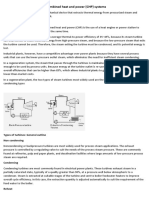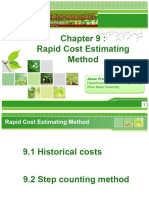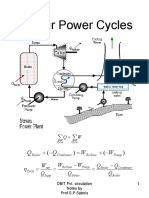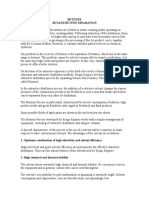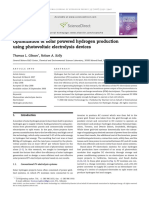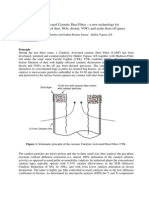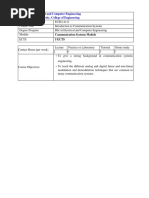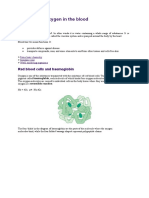SCR and CO Catalyst Requirements-Ken Jeffers, Johnson Matthey
SCR and CO Catalyst Requirements-Ken Jeffers, Johnson Matthey
Uploaded by
Joseph RileyCopyright:
Available Formats
SCR and CO Catalyst Requirements-Ken Jeffers, Johnson Matthey
SCR and CO Catalyst Requirements-Ken Jeffers, Johnson Matthey
Uploaded by
Joseph RileyOriginal Description:
Copyright
Available Formats
Share this document
Did you find this document useful?
Is this content inappropriate?
Copyright:
Available Formats
SCR and CO Catalyst Requirements-Ken Jeffers, Johnson Matthey
SCR and CO Catalyst Requirements-Ken Jeffers, Johnson Matthey
Uploaded by
Joseph RileyCopyright:
Available Formats
Worldwide Pollution
Control Association
Michigan Coal to Gas Seminar
J une 5-6, 2012
Visit our website at www.wpca.info
All presentations posted on this website are copyrighted by the Worldwide Pollution
Control Association (WPCA). Any unauthorized downloading, attempts to modify or to
incorporate into other presentations, link to other websites, or to obtain copies for any
other purposes than the training of attendees to WPCA Conferences is expressly
prohibited, unless approved in writing by the WPCA or the original presenter. The
WPCA does not assume any liability for the accuracy or contents of any materials
contained in this library which were presented and/or created by persons who were
not employees of the WPCA.
SCR/CO Catalyst Considerations
Ken Jeffers
WPCA/Gulf Power
Coal to Gas Conversion Seminar
Detroit, FL
June 5-6, 2012
Topics
Regulatory Drivers for Controlling Emissions NO
x
, CO
SCR Catalyst for NO
x
control
CO oxidation catalyst
Regulatory Drivers - NO
x
Control
NO
2
is 1 of 6 criteria pollutants
Respiratory irritant, contributes to low-level ozone formation
Regulated per EPA NAAQS
MATS, Amendments to NSPS: NO
x
emission limit 0.7 lb/MWh
Further controls necessary per CSAPR which requires:
23 states to reduce SO
2
and NO
x
to help downwind states attain 2006
24-hour and/or 1997 annual PM
2.5
NAAQS
20 states to reduce Ozone Season NO
x
to help downwind areas attain
1997 8-hour Ozone NAAQS
CSAPR States
Regulatory Drivers - CO Control
CO is 1 of 6 criteria pollutants
Majority of CO emissions come from mobile sources
CO displaces oxygen to the heart and brain
Contributes to low-level Ozone formation
CO + 2O
2
CO
2
+ O
3
NAAQS for CO
8-hour average: </= 9 ppmv
1-hour average: </=35 ppmv
Fossil Fuel Air Emissions Comparison
(lb/MMBTU of Energy Input)
Pollutant Natural Gas Oil Coal
Carbon Dioxide 120 160 200
Carbon Monoxide 0.040 (?) 0.03 0.20
Nitrogen Oxides 0.35 0.40 0.40
Sulfur Dioxide 0.001 1.0 2.5
Particulates 0.007 0.08 2.7
Mercury 0.000 0.007 x 10
-3
0.016 x 10
-3
SCR Catalyst for NO
x
Control
SCR Configuration with Coal-fired Boilers
High Dust
Source: The Babcock and Wilcox Company www.babcock.com/products
SCR Configuration with Coal-fired Boilers
Low Dust
Air
Preheater
Hot-Side ESP
SCR Catalyst Types
Plate
Honeycomb Corrugated
Plate-type Catalyst
Composition
Stainless steel expanded mesh
substrate, coated with ceramic
material
TiO
2
, V-oxide/W-oxide/Mo-oxide
Notches formed into plates provide
separation
Inserted in element boxes with
variable spacing: 60 to 90 plates
Variable plate height up to 700 mm
Advantages
Ideal for high dust configurations
Plugging, erosion resistance
Low pressure loss
Honeycomb Catalyst
Composition
Homogeneously extruded ceramic with
square-opening cell structure
TiO
2
, V-oxide/W-oxide
Variable block height up to 1300 mm
Pitch: 2.1 mm 9.2 mm
Advantages
Ideal for low/no-dust applications
High active surface area per unit volume
pitch pitch
pitch pitch
Pitch = center to center distance from one plate/wall to the next
Catalyst Pitch and Structure
Plate-Type Structure
Flexible plates
Rectangular openings
Pitch: 5 to 7 mm
Honeycomb Structure
Rigid structure
Square openings
Pitch: 2.1 to 9.2 mm
Pitch Selection by Application
Application Plate Pitch Honeycomb Pitch
Natural Gas, Diesel -
2.1 mm (70 x 70 cell)
3.7 mm (40 x 40 cell)
Tail-End, Low-dust 5.0 5.6 mm
3.7 mm (40 x 40 cell)
6.7 mm (22 x 22 cell)
Fuel Oil 5.0 5.6 mm
4.9 mm (30 x 30 cell)
6.4 mm (23 x 23 cell)
Bituminous Coal 5.6 6.0 mm
6.7 mm (22 x 22 cell)
8.2 mm (18 x 18 cell)
PRB Coal 5.6 7.0 mm
8.2 mm (18 x 18 cell)
9.2 mm (16 x 16 cell)
Lignite 6.0 7.0 mm ? (no US examples)
Catalyst Modules for Utility SCRs
Catalyst elements arranged in steel frames
Plate 2 levels of 8 element boxes
Honeycomb 72 monoliths
Standardized cross-section
Possible to interchange catalyst types within
reactor
Module height varies with catalyst height
Suitable Operating Conditions
Flue Gas Temperature: 600 800 F
Flue gas linear flow velocity: 5.0 6.0 m/s
Thorough NH
3
-NO
x
mixing: 5% RMS (required for >85% deNOx with
low NH
3
slip)
For flue gas with particulate matter, need
Popcorn ash/LPA screens upstream of SCR reactor
Soot-blowers or sonic horns at catalyst layers
Means to keep catalyst dry and frost-free during outage periods
SCR Catalyst Deactivation
R
e
l
a
t
i
v
e
A
c
t
i
v
i
t
y
/
P
o
t
e
n
t
i
a
l
Operating Time
NG
Bituminous Coal
PRB Coal
Biomass
Masking:
Macroscopic blockage
of catalyst surface
by cemented fly ash
Plugging:
Microsopic blockage of
pore system
by small fly ash particles
Poisoning:
Deactivation of active
sites by chemical attack
Catalyst Surface
Pore
System
Small Fly Ash Particles
Catalyst Surface
Pore
System
Cemented Fly Ash
Catalyst Surface
Pore
System
Active Sites
Catalyst Deactivation Mechanisms
Advantages with Gas-firing
Catalyst Selection For Coal . . .
Large pitch to avoid ash plugging
Minimized SO
2
-SO
3
oxidation
Frequent replacement every 2 years
For Natural Gas firing . . .
Much slower catalyst deactivation longer catalyst life
Fewer catalyst replacements
No fly ash plugging
No Sulfur no ABS, can tolerate higher NH
3
slip
Possible reduced NO
x
reduction requirements
If 100% gas, can use higher cell density catalyst reduced volume
requirement
Sizing Examples
Base Bit Coal
Case
NG equal NO
x
load
NG reduced
NO
x
load
NO
x
in 300 ppmvd 300 ppmvd 240 ppmvd
NO
x
out 40 ppmvd 40 ppmvd 40 ppmvd
NO
x
Reduction 87% 87% 83%
NH
3
slip 2 ppmvd 2 ppmvd 5 ppmvd
Rel P0 1.00 0.83 0.77
Catalyst Pitch 5.6 mm plate 3.7 mm HC 3.7 mm HC
Relative Volume 1.00 0.26 0.21
Pressure drop 1.7 iwg 1.9 iwg 1.5 iwg
Catalyst Options for Coal to Gas Conversion
For Units already having SCR with coal-fired catalyst
Conversion to 100% Gas firing is OK
Remove portion of coal-fired catalyst for reuse in other coal units
Replace all coal-fired catalyst with gas-fired catalyst
If coal will be backup fuel or co-fired, gas-specific catalyst is not suitable
Fly ash plugging
High SO
2
SO
3
oxidation
If SCR required on unit after conversion
Conversion to 100% Gas firing install gas-fired catalyst
Conversion to Gas with Coal backup or co-firing gas and coal need catalyst
suitable for coal-firing.
CO Oxidation Catalyst
Oxidizes CO and VOCs to CO
2
Stainless steel foil or ceramic
honeycomb substrate, high surface
area alumina washcoat, Platinum
Group Metals (PGM) embedded in
washcoat
Blocks with 25 cpsi 400 cpsi
Standard block is 24 x 24, 200 cpsi
metal foil for gas turbine applications
Variable block cross-section possible
Metal foil depths of 1.5 5 inches
Catalyst conversion efficiency depends on catalyst durability, reactant
residence time and the active surface area of the catalyst
Catalyst activity maximized by dispersing the active metals throughout
the high surface-area washcoat on the substrate media
Substrate
Washcoat
Active Sites
Catalyst Conversion Efficiency
Catalyst Light-Off Temperature range at
which conversion occurs
CO Oxidation Catalyst Performance
Fuels Suitable for NG or ULSD
CO Reduction
50 - 95+% Range
80 - 90% Typical
VOC Reduction
0 70% Range
0 50% Typical
Pressure Drop
1.0 iwg Typical
Performance Guarantee Period
3 years or 5 years Typical
Oxidation Catalyst Placement
CCGT HRSG Example
Oxidation Catalyst Placement in a Boiler
Source: The Babcock and Wilcox Company www.babcock.com/products
Possible CO catalyst
location upstream from
NH
3
injection for SCR
Catalyst Deactivation Mechanisms
Thermal deactivation: (typically irreversible) Occurs above 1200 F
Failure of substrate material
Sintering of active catalytic species
Sintering of support
Reaction of catalyst materials
Catastrophic thermal event
Poisoning: (typically reversible)
Chemical (selective) contamination of active sites
Physical (non-selective) contamination
masking, fouling, plugging of cells/pores, washcoat attrition
Catalyst Deactivators (Poisons)
Heavy and Base Metals:
- Lead (Pb) - Iron (Fe)
- Arsenic (As) - Chrome (Cr)
- Zinc (Zn) - Phosphorous (P)
- Copper (Cu) - Silicon (Si)
- Sulfur (S) - Nickel (Ni)
- Mercury (Hg) - Antimony (Sb)
- Tin (Sn)
High Molecular Weight Organic Material
Dust and Particulates
CO Catalyst NOT SUITABLE FOR COAL-FIRED APPLICATIONS
Selective (Chemical) Poisoning
Example Sulfur can react directly with active site and degrade
performance.
Pt + S PtS alloy
Alloy has low activity
(For certain poisons it
is possible to reactivate
the catalyst by thermal
treatment)
Catalyst Regeneration or Cleaning Options
Thermal
Elevating Temperature
Oxidizes organic material
Physical
Vacuuming or Compressed Air Blowing
Removes dust and debris
Chemical (including DI Water)
Washing
Removes masking agents
Restores surface area
Reduces poison concentration
CO Catalyst Options if required after Coal to Gas
Conversion
Suitable for units converted to 100% Gas firing
Not suitable for coal firing (or fuels containing particulate and Sulfur)
Back-up fuel or co-firing
Suitable for low S fuel oil / ULSD / Light oil (?) used as back-up fuel.
Firing should be limited Typically < 500 hours per year
Not suitable for HFO
Summary Points
Gas-firing has many advantages for SCR
Slower deactivation longer lifetime
Low/No Sulfur No ABS, higher NH
3
slip tolerable
No fly ash/particulate plugging
May result in Lower NO
x
load, lower deNOx requirement
Low pitch, high cell density catalyst elements lower volume
requirement as compared to coal applications
Catalyst sized for natural gas not suitable for coal-firing
CO Oxidation catalyst suitable for gas-firing and low/no sulfur fuels
High rates of CO oxidation are possible
CO Oxidation catalyst is not suitable for coal-firing or fuels with
ash/particulate
Thank You!
Ken Jeffers
Sr. Applications Engineer
ken.jeffers@jmusa.com
678 341 7523
You might also like
- Viscosity of Gases and Gas MixturesDocument248 pagesViscosity of Gases and Gas MixturesSangHao NgNo ratings yet
- High-Performance Condenser Tube Cleaning System Featuring Advanced Ball Collecting Technology - r2005 - 03 - 104 PDFDocument5 pagesHigh-Performance Condenser Tube Cleaning System Featuring Advanced Ball Collecting Technology - r2005 - 03 - 104 PDFnur hamzahNo ratings yet
- Multiphase Reactor Engineering for Clean and Low-Carbon Energy ApplicationsFrom EverandMultiphase Reactor Engineering for Clean and Low-Carbon Energy ApplicationsYi ChengNo ratings yet
- Steam Turbine CogenerationDocument5 pagesSteam Turbine CogenerationChemical engineeringNo ratings yet
- Case Study On Fuel Supply SystemDocument7 pagesCase Study On Fuel Supply Systemநெகின் ஜோசுவாNo ratings yet
- Tower BoilerDocument21 pagesTower BoilerJagadeesan SaiNo ratings yet
- The Process Piping: Introduction To Ori Ce FlangeDocument6 pagesThe Process Piping: Introduction To Ori Ce FlangeMohamed AdelNo ratings yet
- Transat Particles in PipesDocument17 pagesTransat Particles in Pipesمحمد توفيق عراقيNo ratings yet
- Fail Free Commissioning-Steam Turbine Lube Oil SystemDocument24 pagesFail Free Commissioning-Steam Turbine Lube Oil SystemPrabhudhasanNo ratings yet
- 142 Yer HS PSM 0001Document75 pages142 Yer HS PSM 0001Janakiraman MalligaNo ratings yet
- Chapter 9 Rapid Cost EstimatingDocument68 pagesChapter 9 Rapid Cost Estimatingภูมิรพี ศรีโวทานัยNo ratings yet
- PDFDocument123 pagesPDFPrakash WarrierNo ratings yet
- Fluid Mechanics and Thermodynamics of Turbomachinery (2014)Document2 pagesFluid Mechanics and Thermodynamics of Turbomachinery (2014)Anonymous g3MQl8No ratings yet
- Asme GT2005-68799 PDFDocument9 pagesAsme GT2005-68799 PDFJeeEianYannNo ratings yet
- Unit 5 Sulphur Recovery Unit PDFDocument32 pagesUnit 5 Sulphur Recovery Unit PDFMohamed AdelNo ratings yet
- X.S. Bai Turbulent Premixed FlamesDocument52 pagesX.S. Bai Turbulent Premixed FlamesIka WidyasariNo ratings yet
- Air Receivers Sizing - 240717 - 225619Document20 pagesAir Receivers Sizing - 240717 - 225619heno82No ratings yet
- Nioec SP 70 23Document15 pagesNioec SP 70 23Mohammad AminiNo ratings yet
- N10DC2432-4 NitrogenGenerationPlant NB95Document31 pagesN10DC2432-4 NitrogenGenerationPlant NB95ionut nicolaeNo ratings yet
- HRSG ReportDocument46 pagesHRSG Reportoverlord5555No ratings yet
- 6.vapour Power CyclesDocument18 pages6.vapour Power CyclesJayneel Gajjar100% (1)
- PB ReciprocatingEnginesDocument29 pagesPB ReciprocatingEngines_guybrush_100% (1)
- KSB MIL Controls Limited Valve Specification SheetDocument2 pagesKSB MIL Controls Limited Valve Specification SheetPablo TorresNo ratings yet
- IND 202 U2a Gas and Liquid Separation FCivan XXDocument61 pagesIND 202 U2a Gas and Liquid Separation FCivan XXrenatoNo ratings yet
- 37 - 4 - Washington DC - 08-92 - 1855 PDFDocument9 pages37 - 4 - Washington DC - 08-92 - 1855 PDFMohamadMostafaviNo ratings yet
- Natural Gas Process InstrumentationDocument4 pagesNatural Gas Process InstrumentationaaashfNo ratings yet
- Superheated SteamDocument15 pagesSuperheated SteamluriahNo ratings yet
- Compressors BrochureDocument8 pagesCompressors BrochureRanto GunawanNo ratings yet
- Laws of Thermodynamics - NewDocument20 pagesLaws of Thermodynamics - NewPeter CheaNo ratings yet
- AIGA 075 - 11 Cal Method For Prevention of Overpress - Cryogenic Tanks - Reformated Jan 12 PDFDocument57 pagesAIGA 075 - 11 Cal Method For Prevention of Overpress - Cryogenic Tanks - Reformated Jan 12 PDFdaimon_pNo ratings yet
- Valve Sizing Selection 1231875721684103 3Document15 pagesValve Sizing Selection 1231875721684103 3adewunmi olufemiNo ratings yet
- Ulman Part 10Document1,000 pagesUlman Part 10Yana RahmadaniNo ratings yet
- Study of Vapour Absorption System Using Waste Heat-F0283439Document6 pagesStudy of Vapour Absorption System Using Waste Heat-F0283439Anonymous NGXdt2BxNo ratings yet
- HeyhhuDocument10 pagesHeyhhuAbhijeet JhankalNo ratings yet
- Furnace Heater DesignDocument7 pagesFurnace Heater DesignMubashir fareedNo ratings yet
- Hinds Errata Text BookDocument9 pagesHinds Errata Text BookJorn DoeNo ratings yet
- English General VRUDocument23 pagesEnglish General VRUzubair1951No ratings yet
- Waste Heat RecoveryDocument18 pagesWaste Heat RecoverywaleedyehiaNo ratings yet
- H2 Fuelled Internal Combustion EngineDocument8 pagesH2 Fuelled Internal Combustion EnginePRASAD326No ratings yet
- Timera Gas V Coal Switching 190515Document15 pagesTimera Gas V Coal Switching 190515Eva PebrianiNo ratings yet
- A Fluid Dynamic Model of The Draft Tube Gas-Liquid-Solid Fluidized BedDocument13 pagesA Fluid Dynamic Model of The Draft Tube Gas-Liquid-Solid Fluidized BedAmudha SivakumarNo ratings yet
- Boiler PerformanceDocument20 pagesBoiler Performancesameer betalNo ratings yet
- Adsorption Chiller Brochure 1 PDFDocument3 pagesAdsorption Chiller Brochure 1 PDFUilson FigueiraNo ratings yet
- CryoStar PresentationDocument26 pagesCryoStar PresentationLelosPinelos123No ratings yet
- Thesis Syed AbbasDocument263 pagesThesis Syed AbbasabubakarNo ratings yet
- Usando El Software HintDocument19 pagesUsando El Software HintGabriel Castro CamposNo ratings yet
- BUTENEXDocument5 pagesBUTENEXIppo MakunouchiNo ratings yet
- Installing Vapor Recovery Units To Reduce Methane LossesDocument29 pagesInstalling Vapor Recovery Units To Reduce Methane Lossesandres100% (1)
- Surge Suppression Air ValvesDocument2 pagesSurge Suppression Air ValvesjyothiprakashNo ratings yet
- Optimization of Solar Powered Hydrogen PDocument10 pagesOptimization of Solar Powered Hydrogen PLara LatakiaNo ratings yet
- Vapor Phase Pressure Drop MethodsDocument32 pagesVapor Phase Pressure Drop MethodsjamestppNo ratings yet
- KKS PltguDocument1 pageKKS PltguArief Rahman100% (1)
- Throttling ProcessDocument3 pagesThrottling ProcessFarhatul Abrar AnandaNo ratings yet
- 3 - ReboilersDocument59 pages3 - ReboilersGeorgio BteichNo ratings yet
- Gatecycle Modeling Exercise PDFDocument50 pagesGatecycle Modeling Exercise PDFHeriyanto Tqn Bin BakriNo ratings yet
- Flash Vessel Spirax Sarco FV-FINALDocument3 pagesFlash Vessel Spirax Sarco FV-FINALkawkatr100% (1)
- Forest Product Conversion FactorsFrom EverandForest Product Conversion FactorsNo ratings yet
- Process System Value and Exergoeconomic Performance of Captive Power PlantsFrom EverandProcess System Value and Exergoeconomic Performance of Captive Power PlantsNo ratings yet
- Exhaust Gas After TreatmentDocument32 pagesExhaust Gas After TreatmentMajid KhanNo ratings yet
- STM Dosing and Feeding Systems For Air Pollution ControlDocument42 pagesSTM Dosing and Feeding Systems For Air Pollution ControlJoseph RileyNo ratings yet
- STMEco Competitive DesignsDocument17 pagesSTMEco Competitive DesignsJoseph RileyNo ratings yet
- STMEco Competitive DesignsDocument17 pagesSTMEco Competitive DesignsJoseph RileyNo ratings yet
- BCMOE WTE Emissions FinalDocument325 pagesBCMOE WTE Emissions FinalJoseph Riley100% (1)
- COMPENDIUM - Retrofitting of Electrostatic Precipitators: Written by Christian AndersenDocument8 pagesCOMPENDIUM - Retrofitting of Electrostatic Precipitators: Written by Christian AndersenJoseph RileyNo ratings yet
- Catalytic Activated Ceramic Dust Filter For Removal of Dust NOx Dioxin and VOCs 2006Document5 pagesCatalytic Activated Ceramic Dust Filter For Removal of Dust NOx Dioxin and VOCs 2006Joseph RileyNo ratings yet
- Dust Control HandbookDocument314 pagesDust Control HandbookJoseph RileyNo ratings yet
- Two Dimensional KinematicsDocument9 pagesTwo Dimensional Kinematicsonyx sallivaramNo ratings yet
- Chapter 10 Endocrine SystemDocument8 pagesChapter 10 Endocrine SystemCriscia Lene OlatNo ratings yet
- Bed 1st Year Assignments Jan 2019 (English)Document5 pagesBed 1st Year Assignments Jan 2019 (English)Trendy RexNo ratings yet
- Horti-Crop Production CGDocument5 pagesHorti-Crop Production CGCarlz Brian100% (1)
- Introduction To Communication System Course OutlineDocument3 pagesIntroduction To Communication System Course OutlineBirhanu MelsNo ratings yet
- LNB For KU BandDocument6 pagesLNB For KU BandPhyo ThuNo ratings yet
- ED Higher Education Economic Development AfricaDocument90 pagesED Higher Education Economic Development AfricaHusenNo ratings yet
- Tiles Report FormatDocument7 pagesTiles Report FormatImran KhanNo ratings yet
- Pelvic Inflammatory Disease CaseDocument25 pagesPelvic Inflammatory Disease CaseKatrina Ramos PastranaNo ratings yet
- What If?Document119 pagesWhat If?workout50No ratings yet
- Cloze Test C Test and VariationsDocument15 pagesCloze Test C Test and VariationsАлёнушкаИи100% (2)
- Assembly Instructions (3) : Make and Attach The Connecting RodsDocument3 pagesAssembly Instructions (3) : Make and Attach The Connecting RodsIram AbifNo ratings yet
- Review - Panasonic AG-HPX370Document56 pagesReview - Panasonic AG-HPX370arthur_8No ratings yet
- ADHIRADocument4 pagesADHIRAWebster ZoneNo ratings yet
- V003t07a008 91 GT 238Document11 pagesV003t07a008 91 GT 238JeromeNo ratings yet
- Formal LanguagesDocument47 pagesFormal LanguagesSourav RoyNo ratings yet
- 1 s2.0 S2214509521003582 MainDocument14 pages1 s2.0 S2214509521003582 MainRaditya Hena Putra UtomoNo ratings yet
- Le ModulorDocument14 pagesLe Modulorabdi50% (4)
- Cambridge IGCSE: Economics 0455/12Document12 pagesCambridge IGCSE: Economics 0455/12DavidNo ratings yet
- NextInnovation ReportDocument41 pagesNextInnovation ReportShahzȝb KhanNo ratings yet
- Transport of Oxygen in The BloodDocument3 pagesTransport of Oxygen in The BloodSoha SonaNo ratings yet
- Cell Cycle Synchronization - Facebook Com LinguaLIBDocument345 pagesCell Cycle Synchronization - Facebook Com LinguaLIBRowin Andres Zeñas PerezNo ratings yet
- Tendernotice 1Document18 pagesTendernotice 1ashishntpc1309No ratings yet
- Digital Signal Processing c1Document20 pagesDigital Signal Processing c1Meliza SiotingNo ratings yet
- ParrotOSPressentation MohamedDaoudDocument14 pagesParrotOSPressentation MohamedDaoudRodrigo Markez RomeroNo ratings yet
- Pride and Prejudice !Document8 pagesPride and Prejudice !DanielaNo ratings yet
- Trade Unions: by Avantika MahajanDocument13 pagesTrade Unions: by Avantika MahajanAvantika MahajanNo ratings yet
- O LEVEL MATHS B D Formula BookletDocument24 pagesO LEVEL MATHS B D Formula BookletSubapro100% (1)
- Deposit Slip For Bank: User ID NTL No Invoice No Billing MonthDocument1 pageDeposit Slip For Bank: User ID NTL No Invoice No Billing Monthm saadullah khanNo ratings yet
- Annual Work Accident Illness Exposure Data ReportDocument1 pageAnnual Work Accident Illness Exposure Data ReportedzNo ratings yet



